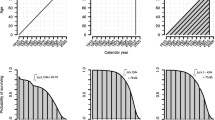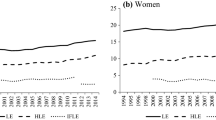Abstract
Although many countries’ populations have experienced increasing life expectancy in recent decades, quality of life (QoL) trends in the general population have yet to be investigated. This paper investigates whether QoL changed for the general Dutch population over the period 2001–2008. A beta regression model was employed to address specific features of the QoL distribution (i.e., boundedness, skewness, and heteroskedasticity), as well non-linear age and time trends. Quality-adjusted life expectancy (QALE) was calculated by combining model estimates of mean QoL with mortality rates provided by Statistics Netherlands. Changes in QALE were decomposed into those changes caused by QoL changes and those caused by mortality-rate changes. The results revealed a significant increase in QoL over 2001–2008 for both genders and most ages. For example, QALE for a man/woman aged 20 was found to have increased by 2.3/1.9 healthy years, of which 0.6/0.8 was due to QoL improvements.




Similar content being viewed by others
Notes
In gamlss a generalized Akaike information criterion (GAIC) is implemented \({\text{GAIC}} = {\text{GD}} + \lambda \times df\), where \(\lambda\) is the penalty, \({\text{GD}}\) is the global fitted deviance \({\text{GD}} = - 2L\) with \(L\) is the fitted log likelihood function. The user can chose various penalties, however the most widely used ones are \(\lambda = 2\) and \(\lambda = \log (n).\) Whereas for \(\lambda = 2\), Akaike criterion is derived, for \(\lambda = \log (n)\) with \(n\) being the sample size, the Schwarz Bayesian criterion (SBC) is obtained. In this study, we chose to use AIC over SBC because the AIC splines were smoother and gave a more convincing visual fit to the data.
References
Cutler, D., Deaton, A., Lleras-Muney, A.: The determinants of mortality. J. Econ. Perspect. 20(3), 97–120 (2006)
Statistics Netherlands: Statline (2011)
Mackenbach, J.P., Slobbe, L., Looman, C.W., van der Heide, A., Polder, J., Garssen, J.: Sharp upturn of life expectancy in the Netherlands: effect of more health care for the elderly? Eur. J. Epidemiol. 26(12), 903–914 (2011)
Gruenberg, E.M.: The failures of success. Millbank Q. 55, 3 (1977)
Fries, J.F.: Compression of morbidity in the elderly. Vaccine 18(16), 1584 (2000)
Eggleston, K.N., Fuchs, V.R.: The new demographic transition: most gains in life expectancy now realized late in life. J. Econ. Perspect. 26(3), 137–156 (2012)
Leon, D.A.: Trends in European life expectancy: a salutary view. Int. J. Epidemiol. 40(2), 271–277 (2011)
Wilmoth, J.R.: Demography of longevity: past, present, and future trends. Exp. Gerontol. 35(9–10), 1111 (2000)
Murray, C.J., Salomon, J.A., Mathers, C.: A critical examination of summary measures of population health. Bull. World Health Organ. 78(8), 981–994 (2000)
Layes, A., Asada, Y., Kepart, G.: Whiners and deniers—what does self-rated health measure? Soc. Sci. Med. 75(1), 1–9 (2012)
Dolan, P.: Handbook of Health Economics, vol. 1, chapter 32. The measurement of health-related quality of life for use in resource allocation decisions in health care. In: Handbook of Health Economics, pp. 1723–1760 (2000)
Brazier, J.E., Roberts, J.: The estimation of a preference-based measure of health from the SF-12. Med. Care. 42(9), 851–859 (2004)
Drummond, M.F., Sculpher, M.J., Torrance, G.W.: Methods for the Economic Evaluation of Health Care Programmes, 3rd edn. Oxford University Press, Oxford (2005)
Cutler, D.M., Richardson, E.: Measuring the health of the US population. Brookings papers on economic activity. Microeconomics 1997, 217 (1997)
Williams, A.: Calculating the global burden of disease: time for a strategic reappraisal? Health Econ. 8(1), 1–8 (1999)
Heijink, R., van Baal, P., Oppe, M., Koolman, X., Westert, G.: Decomposing cross-country differences in quality adjusted life expectancy: the impact of value sets. Popul. Health Metrics 9(1), 17-7954-9-17 (2011)
Jia, H., Zack, M.M., Thompson, W.W.: State quality-adjusted life expectancy for U.S. adults from 1993 to 2008. Qual. Life Res. 20(6), 853–863 (2011)
Salomon, J.A., Wang, H., Freeman, M.K., Vos, T., Flaxman, A.D., Lopez, A.D., et al.: Healthy life expectancy for 187 countries, 1990–2010: a systematic analysis for the Global Burden Disease Study 2010. Lancet 380(9859), 2144–2162 (2012)
Kieschnick, R., McCullough, B.D.: Regression analysis of variates observed on (0, 1): percentages, proportions and fractions. Stat. Model. 3(3), 193–213 (2003)
Basu, A., Manca, A.: Regression estimators for generic health-related quality of life and quality-adjusted life years. Med. Decis. Mak. 32(1), 56–69 (2012)
Hunger, M., Baumert, J., Holle, R.: Analysis of SF-6D index data: is beta regression appropriate? Value Health 14(5), 759–767 (2011)
Hunger, M., Doring, A., Holle, R.: Longitudinal beta regression models for analyzing health-related quality of life scores over time. BMC Med. Res. Methodol. 12, 144-2288-12-144 (2012)
Rubin, D.B.: Inference and missing data. Biometrika 63(3), 581 (1976). (581–592, 592)
van Buuren, S., Boshuizen, H.C., Knook, D.L.: Multiple imputation of missing blood pressure covariates in survival analysis. Stat. Med. 18(6), 681–694 (1999)
van Buuren, S., Brand, J.P.L., Groothuis-Oudshoorn, C.G.M., Rubin, D.B.: Fully conditional specification in multivariate imputation. J. Stat. Comput. Simul. 76(12), 1049–1064 (2006)
Raghunathan, T.E., Lepkowski, J.M., Van Hoewyk, J.: A multivariate technique for multiply imputing missing values using a sequence of regression models. Surv. Methodol (2001)
Peyre, H., Leplege, A., Coste, J.: Missing data methods for dealing with missing items in quality of life questionnaires. A comparison by simulation of personal mean score, full information maximum likelihood, multiple imputation, and hot deck techniques applied to the SF-36 in the French 2003 decennial health survey. Qual. Life Res. 20(2), 287–300 (2011)
Rubin, D.B.: Multiple Imputations for Non-Response in Surveys. Wiley, New York (1987)
Pullenayegum, E.M., Tarride, J.E., Xie, F., Goeree, R., Gerstein, H.C., O’Reilly, D.: Analysis of health utility data when some subjects attain the upper bound of 1: are Tobit and CLAD models appropriate? Value Health 13(4), 487–494 (2010)
Austin, P.C.: A comparison of methods for analyzing health-related quality-of-life measures. Value Health 5(4), 329 (2002). (329–337, 337)
Ferrari, S., Francisco, C.: Beta regression for modelling rates and proportions. J. Appl. Stat. 31(7), 799 (2004). (799–815, 815)
Smithson, M., Verkuilen, J.: A better lemon squeezer? Maximum-likelihood regression with beta-distributed dependent variables. Psychol. Methods 11(1), 54–71 (2006)
Cox, C.C.: Nonlinear quasi-likelihood models: applications to continuous proportions. Comput. Stat. Data Anal. 21(4), 449 (1996). (449–461, 461)
Ospina, R.R.: Inflated beta distributions. Stat. Pap. (Berlin, Germany) 51(1), 111–126 (2010)
Rigby, R.A., Stasinopoulos, D.M.: A Flexible Regression Approach Using GAMLSS in R (2010)
Stasinopoulos, D.M., Rigby, R.A.: Generalized additive models for location scale and shape (GAMLSS) in R. J. Stat. Softw. 23(7), 1 (2007)
Cramer, H.: Mathematical Methods of Statistics. Princeton University Press, Princeton (1946)
Li, L., Fu, A.Z.: Some methodological issues with the analysis of preference-based EQ-5D index score. Health Serv. Outcomes Res. 9(3), 162–176 (2009)
Eilers, P.H.C.: Flexible smoothing using B-splines and penalties (with comments and rejoinder). Stat. Sci. 11(2), 89 (1996)
Hastie, T., Tibshirani, R.: Varying-coefficient models. J. R. Stat. Soc. Ser. B (methodological) 55(4), 757–796 (1993)
Akaike, H.: Information theory and an extension of the maximum likelihood principle. In: Petrov, B.N., Caski, F. (eds.) Proceeding of the second international symposium on information theory. Akademiai Kiado, Budapest, pp. 267–281 (1973)
Schafer, J.L., Olsen, M.K.: Multiple imputation for multivariate missing-data problems: a data analyst’s perspective. Multivar. Behav. Res. 33(4), 545–571 (1998)
Sullivan, D.F.: A single index of mortality and morbidity. HSMHA Health Rep 86(4), 347–354 (1971)
Perenboom, R.J., Van Herten, L.M., Boshuizen, H.C., Van Den Bos, G.A.: Trends in disability-free life expectancy. Disabil. Rehabil. 26(7), 377–386 (2004)
Water, V.D., Boshuizen, H.C., Perenboom, R.J.M.: Health expectancy in the Netherlands 1983–1990. Eur. J. Public Health 6(1), 21–28 (1996)
Picavet, H.S., Hoeymans, N.: Physical disability in The Netherlands: prevalence, risk groups and time trends. Public Health 116(4), 231–237 (2002)
Majer, I.M., Stevens, R., Nusselder, W.J., Mackenbach, J.P., van Baal, P.H.: Modeling and forecasting health expectancy: theoretical framework and application. Demography 50(2), 673–697 (2013)
Bruggink, J.W., Garssen, J., Lodder, B., Kardal, M.: Trends in gezonde levensverwachting (Trends in health expectancy). Centraal Bureau voor de Statistiek, Bevolkingstrend, Den Haag (2009)
Figueroa-Zúñiga, J.J.I., Arellano-Valle, Reinaldo, B., Ferrari Silvia, L.P.: Mixed beta regression: a Bayesian perspective. Comput. Stat. Data Anal. 61, 137 (137–147; 147) (2013)
Muennig, P., Franks, P., Jia, H., Lubetkin, E., Gold, M.R.: The income-associated burden of disease in the United States. Soc. Sci. Med. 61(9), 2018–2026 (2005)
Luo, N., Johnson, J.A., Shaw, J.W., Feeny, D., Coons, S.J.: Self-reported health status of the general adult U.S. population as assessed by the EQ-5D and Health Utilities Index. Med. Care 43(11), 1078–1086 (2005)
Cherepanov, D., Palta, M., Fryback, D.G., Robert, S.A.: Gender differences in health-related quality-of-life are partly explained by sociodemographic and socioeconomic variation between adult men and women in the US: evidence from four US nationally representative data sets. Qual. Life Res. 19(8), 1115–1124 (2010)
Tamhane, A., Ankenmana, B., Yang, Y.: The beta distribution as a latent response model for ordinal data (I): estimation of location and dispersion parameters. J. Stat. Comput. Simul. 72(6), 473–494 (2002)
Fryback, D.G., Dunham, N.C., Palta, M., Hanmer, J., Buechner, J., Cherepanov, D., et al.: US norms for six generic health-related quality-of-life indexes from the National Health Measurement study. Med. Care 45(12), 1162–1170 (2007)
Luo, N., Wang, P., Fu, A.Z., Johnson, J.A., Coons, S.J.: Preference-based SF-6D scores derived from the SF-36 and SF-12 have different discriminative power in a population health survey. Med. Care 50(7), 627–632 (2012)
Graham, J.W.: How many imputations are really needed? Some practical clarifications of multiple imputation theory. Prev. Sci. 8(3), 206–213 (2007)
Acknowledgments
This article is the result of original research that has not been published or submitted elsewhere. This study was made possible through a grant from The Netherlands Organization for Health Research and Development (ZonMW), project number 200400009. No ethics committee approval was required for this study.
Conflict of interest
There are no conflicts of interest to report.
Author information
Authors and Affiliations
Corresponding author
Appendix
Appendix
Multiple imputation model
We used a fully conditional specification (FCS), also known as multivariate imputation by chained equations (MICE), proposed by various authors [24–26] for each SF-12 item with missing values, conditional on all other variables in an imputation model. We developed the imputation model based on variables from the POLS face-to-face interview, in particular: year, age, educational level, marital status, self-rated health, general practitioner (GP) visits, smoking status, number of sport activities per week, happiness, number of working hours per week, number of church visits per month. The number of imputations used was established following pre-defined guidelines [56]. Given the percentage of missing data (around 20–25 % of the SF-12 items) and the computer power necessary, ten imputations were used to impute the SF-12 missing values.
Analyzing multiple imputed data involves two steps: first a standard method is applied to each simulated data set, then the estimates of interest from each data are combined to obtain a final result using the rules defined in [28] and adapted from [42].
Delta method
The delta method estimates the variance of a non-linear function of one or more variables by using the Taylor expansion around the mean of the variables. Therefore, if \(x_{0}\) and \(y_{0}\) are the mean values of \(\mu\) and \(\nu\), respectively, the first order Taylor expansion of \(f(\mu ,\nu ) = \frac{\mu + \nu }{1 + \nu }\) about the values \((x_{0} ,y_{0} )\) is:
Then,
where \(\rho\) is the product moment correlation between \(\mu\) and \(\nu\). If we assume \(\rho = 0\), the estimated variance of the \(f(\mu ,\nu )\) is:
Rights and permissions
About this article
Cite this article
Gheorghe, M., Brouwer, W.B.F. & van Baal, P.H.M. Did the health of the Dutch population improve between 2001 and 2008? Investigating age- and gender-specific trends in quality of life. Eur J Health Econ 16, 801–811 (2015). https://doi.org/10.1007/s10198-014-0630-4
Received:
Accepted:
Published:
Issue Date:
DOI: https://doi.org/10.1007/s10198-014-0630-4




